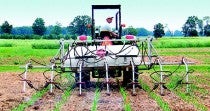Organic & Sustainable Research: No Till, Weed Cotrol, Cover Crops
The field was planted to alfalfa at 28 lbs/A with a nurse crop of oats at 1 bu/A on April 12. Timely rains and warm weather resulted in good establishment of the oats and alfalfa. The oats became competitive with the alfalfa by late May, from advisement of the forage specialist at MSU, the oats were mowed off and removed on June 11. Weeds overtook the 2-3 inch alfalfa after mowing, and were flail mowed and removed on August 6. An excellent alfalfa stand resulted from these management strategies. In 2011, sulphate of potash (SOP, Great Salt Lake Minerals Corporation) and dairy slurry as potassium sources will be compared to an untreated control for their influence on alfalfa yield and quality.
4. Evaluation of eight legume cover crops no-till drilled into wheat stubble and their influence on organic corn yield. Since nitrogen is often a limiting factor for organic corn, a study was conducted to compare several legumes no-till drilled after wheat harvest for their nitrogen contribution to corn the following season. Red clover, hairy vetch and crimson clover resulted in the highest corn yields in 2010 at 117, 105 and 103 bu/A respectively. We drilled Austrian winter pea at two rates, 60 and 90 lbs/A, where the 90 lb. rate resulted in a 5 bushel corn yield gain of 96 bu/A, as compared to 60 lbs/A rate at 91 bu/A. The sweet clover treatment resulted in a corn yield of 97 bu/A, which was comparable to the 90 lb/A Austrian winter pea treatment at 96 bu/A. Vernal alfalfa, chickling vetch and the no cover crop control had the lowest yield of 82, 85 and 84 bu/A respectively.
Our results indicate that in Michigan on sandy loam soils, red clover provided the best corn yield compared to the other tested legumes.
5. Brassica mustard as a cover crop for weed control in the spring. This study involves using two varieties of mustard—Tilney and Ida Gold—which were planted at four separate dates. A quadrant of no cover crop (bare ground) was left in each plot to evaluate weed pressure without cover crops. Biomass samples were taken during the spring. Cover crop biomass was compared to weed biomass. In 2010 we had an early spring and thus allowed us to plant earlier than most seasons. These data should help farmers evaluate mustards as a spring weed control tool. Three states are conducting this experiment—Michigan, New York and Illinois.
6. Organic dry bean production and weed control. A dry bean variety and production trial is being initiated in 2011. We have tested 32 varieties of dry beans over the past three years on our certified organic soil. A more expansive research project at KBS and on organic farms will be evaluated over the next four years.
Other research projects being conducted by the MSUE Cover Crop group at sites other than KBS are organic pumpkins, organic tomatoes, 13 oilseed radish and seven other brassicas variety trial with NRCS and University of Minnesota.
Other Cover Crop Research conducted in 2010:
- Three on farm trials were conducted utilizing the slurry seeding method. Oilseed Radish, oats + turnip and a control without covers were compared. These were field size trials and each treatment was replicated four times. The slurry seeding was compared to drilling the same cover crops and applying liquid manure was the Aerway applicator. One on farm trial; used ceareal rye only which was applied through the slurry seeder.
- An experiment evaluating three rates of nitrogen fertilizer for rye: which was crimped and rolled in the spring, was planted with drilled round-up ready soybeans. There was four replications in a RCB design.
Dr. Dean Baas Cover Crop decision Tool:
- The cover crop decision tool has been completed for Michigan field crops. Four meeting with specialists and educators were conducted to fit cover crop data into the tool for Michigan.
- A vegetable cover crop decision tool has been initiated. We have had one meeting to begin this process.
Dr. Sieg Snapp LTER/KBS cover crop long term research:
- Long-term row crop experimentation at the Kellogg Biological Station Long-term Ecological Research (KBS LTER) has shown that integration of cover crops in a corn-soybean-wheat rotation reduces the nitrogen (N) fertilizer requirement by half. Soil organic matter was enhanced by about 20% after 10 years, and remains higher than conventionally grown crops after 20 years. Experiments are being conducted to test the benefits and challenges associated with growing cover crops at larger scales. This includes a farm-wide experiment at KBS involving 27 fields that are being managed with and without cover crops. Modeling is also being used to evaluate impacts of cover crops on soil and water properties over various temporal and spatial scales.
Profitability and adoption of cover crops has been investigated, where farmers were asked the extent of payments that would be required to compensate for the opportunity costs of growing cover crops that require a later time frame for planting cash crops. Concerns of farmers – with the notable exception of organic farmers- were substantial regarding the inability to grow long-season, high yield potential varieties of cash crops in a cover crop diversified systems (due to delayed planting after cover crops are incorporated in the spring). There was considerable interest at the same time in conservation tillage cropping systems that combined cover crops with strip or other types of reduced tillage so as to maximize soil organic matter building properties associated with cover crops. New research is being initiated on combining various types of conservation tillage and zonal tillage with cover crop systems.




 Your Privacy Choices
Your Privacy Choices
Leave a comment